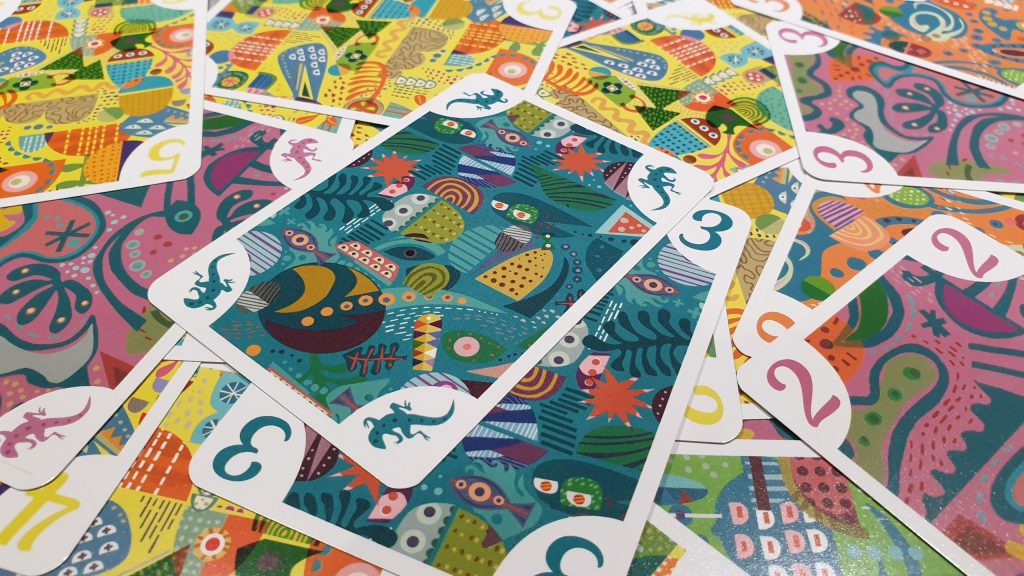5211 is a colourful card game, which utilizes hand management and set collection mechanics, from publisher Next Move Games. Designed by Tsuyoshi Hashiguchi, featuring artwork from Chris Quilliams, the game is a reimplementation of 5 Colors. For around 20 minutes, 2 – 5 players will be playing cards, attempting to bust colours while having some of the majority – though kododos can come into play. While 5211 fits with Next Move’s 4 character title limit does it provide entertainment? Let’s find out!
Setup is as quick as removing a few cards, shuffling the deck and dealing five cards to each player. Place the deck within reach and 5211 is ready to go. The aim is to obtain the most points, via keeping cards. This is achieved by either a perfect number of kododos or playing cards of a specific colour.
With five cards in hand, each round will see players simultaneously play 2 cards, 1 subsequent card and then 1 final card. Each time cards are played each player redraws back up to the full hand of five. Once the round is over the first thing to check is the number of kododo cards played. Depending on the player count the number differs, for example for 4 players exactly 6 kododos need to be played. If this is the case then all other cards are discarded and the players whom played kododos keep those cards in a scoring pile in front of themselves.
If this hasn’t happened then players check the colours (the suits of the cards) – with colours able to go bust. Like with the amount of kododos, the number of cards played before a colour goes bust depends of the player count. In a 4 player game only 6 cards of a colour can be played, else it goes bust.
Cards of busted colours are first discarded, before players determine which colour has the most cards played. Ties between colours sees those colours discarded. After all of this the single colour of cards with the majority played are the cards kept by players to score. The game continues until the deck runs out. At this point players play a final round, without the drawing cards aspect, before scoring. This is done simply by adding up the values of the cards that you added to your score pile, with kododos worth 1 point.

5211 is simple in concept allowing anyone to pick up the game and play. Within a minute players can have learnt the rules and be playing. This isn’t to say they’ll 100% understand how best to play – it can take a few rounds to see how things cancel out and score – but the game can start. The game is all about guessing and reading what you think others may play – what will be played and go bust. This enables the game to be won by a new player, leveling the playing field nicely.
Having the caveat of kododos is a good way to occasionally have a different set of cards “win” the round. It is a twist that the scoring needed, so not quite every round ends the same. You wouldn’t want it to constantly trigger. However, regardless of player count this seems to happen too infrequently. For it to happen you need one player to start the round with half a hand of kododos, forcing the matter, rather than all playing one and it happening surprisingly for all.
There is a fun style and a lot of colour to the artwork of 5211. The patterns help this vibrancy, alas some of the colours are similar when lighting isn’t great. Friendmen Frieese’s Fool may not be as nice to look at but it got around this issue with distinctive shapes for each suit. Having a distinct pattern would have made the coloured suits much easier to tell apart. There have been occasions where a player has played a card thinking it matched one colour when it was another. It is a minor irritation that could have been avoided, and should have been noticed for a card only title.
Simple card games are often the best at handling players dropping in and out between games. This isn’t quite the case with 5211, as it takes a minute into the next game for things to settle. The awkwardness comes specifically from the number change. While it is clearly for balance, the amount of cards for kododo victories and going bust are adjusted alongside the player count. This has confused some when all of a sudden the amount you’re used to changes. For some this will be a non-issue, while others have got frustrated with the game as a result.
The downfall of 5211 is the amount of admin in the game. Players spend as much time drawing cards and counting for a majority as they do choosing and playing cards. Each round players are constantly drawing cards and it disrupts the flow of the game. Also, it might be simple to draw as many cards as you play, still it is easy to forget when trying to play something. Therefore, players can incorrectly end up with only a couple of cards in their hand at the end of the game. The amount of admin just makes the game feel like a bit too much effort, and constantly reminding players to draw cards gets a bit awkward.
5211 is an acceptable card game to play. Alas, there isn’t much to make it feel special – nor is it above a game possible with a standard deck of cards. The colours and style of the artwork makes the cards stand out from other games but not necessarily each other. A welcome twist is the kododo scoring, as when it fleetingly occurs it adds flair to the scoring. The speed of the game with the drawing and counting is what lets the experience down. It might be fun to play for a while but I cannot see it becoming a go to game, with so many released every year.
(Editor’s Note: 5211 was provided to us by Asmodee for the review. The game is currently available from local board game stores, find your local store here.)

